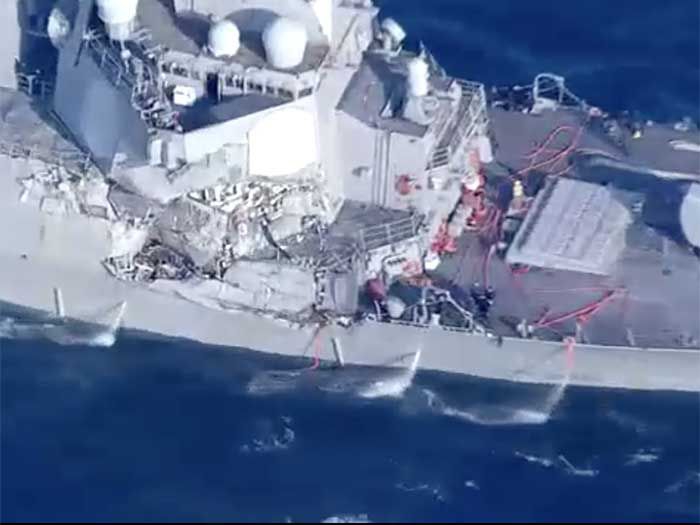
GAO: U.S. Navy sailors still not getting enough sleep
Written by Nick Blenkey
Damage sustained by USS Fitzgerald in collision with containership: Fatigue was identified as one factor in fatal incident.
Following the fatal collisions with civilian ships involving the USS Fitzgerald and the USS John S. McCain in the summer of 2017, the U.S. Navy found that sailor overwork, fatigue, and training deficiencies contributed to the accidents. It took steps to address these issues that included issuing a fatigue management policy.
A new report from the U.S Government Accountability Office (GAO) finds that policy has been inconsistently implemented and that sailors are not receiving adequate sleep.
GAO conducted a survey in 2020 and estimates that 14% of officers received the then recommended 7 hours or more of sleep a day during their most recent deployment, while 67% received 5 hours or less.
Navy data show that sailor effectiveness declines after prolonged periods without sleep, equating to impairment levels comparable to intoxication. The Navy updated its policy in December 2020—directing adherence to fatigue guidelines—and is taking steps to improve implementation, but is limited by a lack of quality information on sailor fatigue and the factors that cause lack of sleep. Without this information, the Navy cannot effectively manage fatigue to ensure crews operate ships safely.
The Navy routinely assigns fewer crewmembers to its ships than its workload studies have determined are needed to safely operate them.
Until recently, the Navy tracked and internally reported its crewing against the number of funded positions rather than against required positions, a practice which understated crewing shortfalls. As a result, the Navy did not accurately measure the full extent of shortfalls, which almost doubled on average from 8 percent in October 2016 to 15 percent in September 2020. Although the Navy began tracking required positions in February 2021, this practice is not reflected in guidance.
The Navy also uses funded positions, rather than requirements, to project its future personnel needs. Therefore, it is not accurately communicating to internal decision makers the number of personnel it will need as the fleet grows, which may prevent it from effectively mitigating current crewing shortfalls.
The Navy’s Ready Relevant Learning (RRL) initiative is intended to improve sailor performance, and the Navy has several ongoing and planned measures to assess its effectiveness. However, says GAO, delivering modernized training will require significant upgrades to the Navy’s information technology infrastructure, for which it has only recently begun planning. In addition, the Navy has not accounted for the time that sailors will be expected to spend on modernized training when it is fielded, which may exacerbate sailor overwork and fatigue.
GAO is making eight recommendations to the Department of Navy:
- The Secretary of the Navy should ensure that the Office of Chief of Naval Operations and the Commander, U.S. Fleet Forces Command and Commander, U.S. Pacific Fleet revise guidance to require systematic collection of quality and timely fatigue data from sailors that are accessible to operational commanders to support underway decision-making. (Recommendation 1)
- The Secretary of the Navy should ensure that the Office of Chief of Naval Operations and the Commander, U.S. Fleet Forces Command and Commander, U.S. Pacific Fleet use collected data on sailor fatigue to identify, monitor, and evaluate factors that contribute to fatigue and inadequate sleep such as the effects of crew shortfalls, work requirements, administrative requirements, and collateral duties. (Recommendation 2)
- The Secretary of the Navy should ensure that the Office of Chief of Naval Operations and the Commander, U.S. Fleet Forces Command and Commander, U.S. Pacific Fleet take actions to address the factors causing sailor fatigue and inadequate sleep. (Recommendation 3)
- The Secretary of the Navy should ensure that the Office of Chief of Naval Operations and the Commander, U.S. Fleet Forces Command and Commander, U.S. Pacific Fleet establish a process for identifying and assisting units that have not implemented its fatigue management policy. (Recommendation 4)
- The Secretary of the Navy should ensure that the Office of Chief of Naval Operations and the Commander, U.S. Fleet Forces Command and Commander, U.S. Pacific Fleet revise guidance to institutionalize the practice of using crew requirements to track and report positions that are filled. (Recommendation 5)
- The Secretary of the Navy should ensure that the Commander, U.S. Fleet Forces Command and Commander, U.S. Pacific Fleet establish crewing targets that are based on analysis and assessment of risk. (Recommendation 6)
- The Secretary of the Navy should ensure that the Office of Chief of Naval Operations uses crew requirements to project future personnel needs. (Recommendation 7)
- The Secretary of the Navy should ensure that the Office of the Chief of Naval Operations accounts for additional sailor workload resulting from the continued implementation of Ready Relevant Learning when determining crew requirements. (Recommendation 8)




